ORDER
Psittaciformes
FAMILY
Psittacidae
GENUS & SPECIES
KEY FEATURES
• One of the most abundant species of I parrot in Australia
• Huge flocks of budgerigars often gather for protection against predators when they fly in to drink at scattered waterholes
• Bred in a range of colors in captivity, this bird is always green in the wild so that it remains camouflaged in its scrub and woodland home
WHERE IN THE WORLD?
Distributed across Australia’s dry interior; absent only from thelM extreme southwest, the far north, the coastal strip east of the Great Dividing Range and Tasmania; introduced in Florida

Lifecycle
Although it’s best known as a solitary cage bird, the budgerigar is a gregarious parrot that joins others to form great wheeling flocks containing thousands of birds.
HABITAT
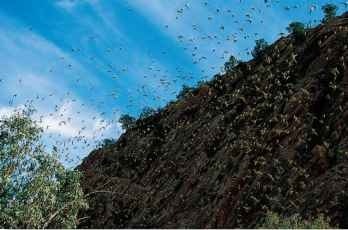
A Cheep and cheerful Noisy flocks of budgerigars sweep over dry, open areas of the Outback.
The budgerigar is found mainly in the sparsely populated semi-wilderness of Australia’s interior; the Outback, which covers 2 million sq. miles of land to the west of the Great Dividing
Range. A sociable bird, it flies in flocks over dry open grassland and farmland, roosting among scattered acacia trees and eucalyptus scrub. The budgerigar avoids the mountains and forests of the east, but flocks have been seen flying southeast toward Melbourne and into lush southwestern parts of western Australia.
Rarely venturing far from water, the bird is seldom found in areas prone to drought. Unlike many of Australia’s native birds, it has benefited from the expansion of farming land.The permanent supplies of water in tanks built by sheep farmers have enabled the budgerigar to inhabit areas where it was formerly absent.
CONSERVATION
Although budgerigar numbers fluctuate widely, the population is believed to be several hundred thousand strong despite the deaths regularly caused by severe drought.Apart from such natural disasters, the budgerigar faces few other threats.
BREEDING
The budgerigar breeds all year if sufficient rainfall stimulates a good crop of food. In the south, breeding peaks between August and January; in the north, from June to September The budgerigar breeds in large colonies, pairing for long periods, possibly for life.
Nests are made in tree holes, stumps, posts or even logs. The white, rounded eggs (usually four to six, occasionally eight) are laid on wood dust at the bottom of the hole. After the female incubates the eggs for 18 days, young hatch and are cared for by both parents for five weeks.Young are first fed on “budgie milk,” a regurgitated food high in protein similar to a mammal’s milk.
The young budgerigar is a duller color than its parents and has dark-brown eyes. Within three or four months, it acquires adult plumage and both sexes are sexually mature and ready to breed.
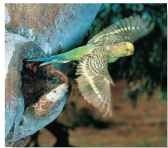
A Quick getaway A swift exit avoids revealing the nest site.
BEHAVIOR
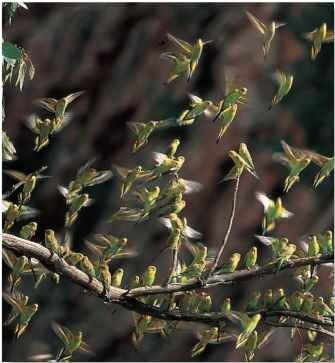
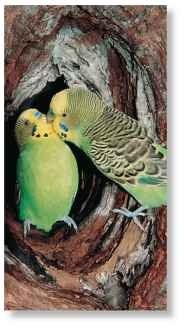
Role model The male budgerigar helps feed and rear his offspring.
FOOD & FEEDING
Grass seeds and herbs form the bulk of the budgerigar’s diet. Seeds are taken directly from the plant or collected from the ground. Ripened seeds of porcupine grass, Mitchell grass, spinifex and saltbush are favored. The budgerigar removes the outer seed casing, then swallows the inner part whole. Feeding usually takes place in the morning and evening, while the hottest part of the day is spent resting and preening in the trees.
In the wild, the budgerigar drinks every day. But drinking in the open can be dangerous; a bird with its head down is vulnerable to attack by predators. Consequently, the budgerigar often gathers in great numbers for safety at waterholes. Indeed, flocks have been known to be so large that successive waves of birds trying to get to the water land on top of those already drinking and drown them.
BEATING ABOUT THE BUSH
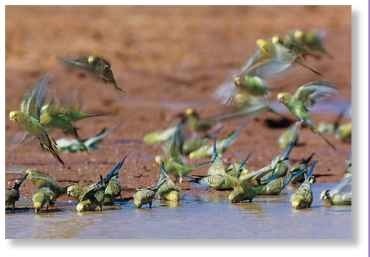
A Bird bath
The colorful budgerigars
arrive at waterholes by the thousands for a daily drink and a nice, cool bath.
The budgerigar is a nomad, moving around in flocks, the size of which vary with food availability and water supplies. Smaller flocks, sometimes with as few as half a dozen birds, occur near the fringes of the continent; the largest flocks are seen in central Australia, especially after heavy rains.
Flying with rapid wingbeats, large budgerigar flocks wheel and twist with precision. Flocking helps the budgerigar find food by increasing the number of eyes looking for feeding areas. The swirling flock on the move also confuses predators by making it difficult for them to target one bird.
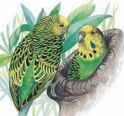
1 Waking up…
As a breeding season approaches, a male and female strengthen their bond by preening each other early in the morning.

2 Sticking together…
They then leave the safety of the trees with the flock, flying quickly to avoid predators.The pair remains close together…

3 Thirsty work…
.. .when the flock stops at a waterhole. In dry conditions, the pair could survive for months without water, but wouldn’t breed.

4 Going to seed
The budgerigar spends most of its time feeding. It uses its feet to climb grass stalks and extracts the seeds with its bill.
In a heat wave in 1932, millions of budgerigars migrated north of Australia in a flock so large that it took four hours to fly over any one spot.
English exhibition budgerigars have been bred to weigh three times the weight of wild birds; some of the males are even too heavy to copulate.
A female budgerigar often feeds the youngest and smallest of her offspring first, giving the whole brood a chance to survive, rather than just the larger chicks.
Profile
Budgerigar
The budgerigar, with its compact, streamlined body and long, tapering wings, is a fast flier that travels long distances in search of food.
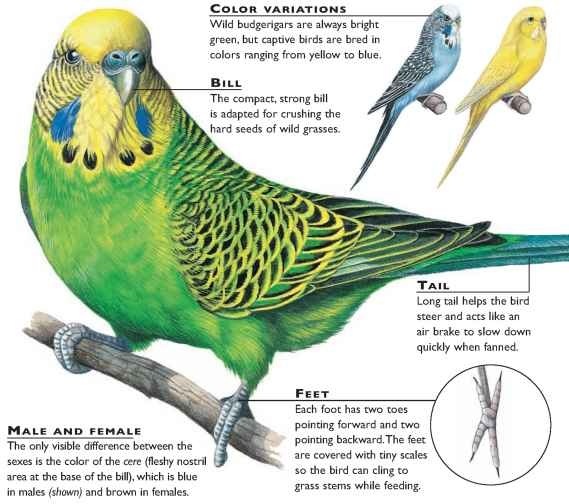
CREATURE COMPARISONS
Twice the length of the budgerigar and four times its weight, the striking crimson rosella (Platycerus elegans) is found in the east and southeast of Australia.The crimson rosella inhabits coastal forests and enjoys a more varied diet than its relative. It lives among eucalyptus and acacia trees and feeds on fruit, blossoms, insects and grass seeds.
Like the budgerigar; it doesn’t shy away from human settlement and may be seen in the outer suburbs of towns and cities. But the crimson rosella doesn’t fly in large flocks or lead as nomadic a life as the budgerigar Adult birds prefer to stay in the same area throughout the year; in small groups or in pairs.
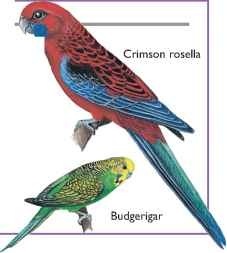
| VITAL STATISTICS | |
| Weight | 1 oz. |
| ‘ Length | 7″ |
| Wingspan | 8″ |
| Sexual 1 Maturity | 3 months |
| i Breeding 1 Season | Throughout the year; varies with location |
| Number of Eggs | 4-6 |
| Incubation Period | 18 days |
| Fledging Period | About 35 days |
| Breeding I Interval | Several broods a year |
| Typical Diet | Grass seeds |
| Lifespan | 7-8 years in the wild; up to 20 in captivity |
RELATED SPECIES
• The budgerigar is the . only member of its genus and belongs to the parrot family, Psittacidae. Of the 330 parrot species, 50 are found in Australia, including the Australian king parrot (below). An inhabitant of forest canopy, this colorful bird feeds on tree seeds.


